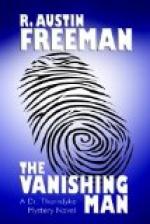“The fourth hypothesis is that Bellingham was murdered by Hurst. Now the one fact which militates against this view is that Hurst apparently had no motive for committing the murder. We are assured by Jellicoe that no one but himself knew the contents of the will, and if this is so—but, mind, we have no evidence that it is so—Hurst would have no reason to suppose that he had anything material to gain by his cousin’s death. Otherwise the hypothesis presents no inherent improbabilities. The man was last seen alive at Hurst’s house. He was seen to enter it and he was never seen to leave it—we are still taking the facts as stated in the newspapers, remember—and it now appears that he stands to benefit enormously by that man’s death.”
“But,” I objected, “you are forgetting that, directly the man was missed, Hurst and the servants together searched the entire house.”
“Yes. What did they search for?”
“Why, for Mr. Bellingham, of course.”
“Exactly; for Mr. Bellingham. That is, for a living man. Now how do you search a house for a living man? You look in all the rooms. When you look in a room, if he is there, you see him; if you do not see him, you assume that he is not there. You don’t look under the sofa or behind the piano, you don’t pull out large drawers or open cupboards. You just look into the rooms. That is what these people seem to have done. And they did not see Mr. Bellingham. But Mr. Bellingham’s corpse might have been stowed away out of sight in any one of the rooms that they looked into.”
“That is a grim thought,” said Jervis; “But it is perfectly true. There is no evidence that the man was not lying dead in the house at the very time of the search.”
“But even so,” said I, “there was the body to be disposed of somehow. Now how could he possibly have got rid of the body without being observed?”
“Ah!” said Thorndyke, “now we are touching on a point of crucial importance. If anyone should ever write a treatise on the art of murder—not an exhibition of literary fireworks like De Quincey’s, but a genuine working treatise—he might leave all other technical details to take care of themselves if he could describe some really practicable plan for disposing of the body. That is, and always has been, the great stumbling-block to the murderer: to get rid of the body. The human body,” he continued, thoughtfully regarding his pipe, just as, in the days of my pupilage, he was wont to regard the black-board chalk, “is a very remarkable object. It presents a combination of properties that makes it singularly difficult to conceal permanently. It is bulky and of an awkward shape, it is heavy, it is completely incombustible, it is chemically unstable, and its decomposition yields great volumes of highly odorous gases, and it nevertheless contains identifiable structures of the highest degree of permanence. It is extremely difficult to preserve unchanged, and




